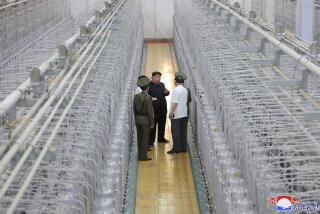N. Korea Working on Missile Accuracy
- Share via
WASHINGTON — North Korea is developing a long-range missile that could hit U.S. targets with greater accuracy than its old missiles, a U.S. official confirmed Thursday.
The missile is based on the old Soviet navy’s SS-N-6, a submarine-launched missile, the official said. North Korea is believed to have acquired it between 1992 and 1998, then added technology to improve the missile. It can now be launched from the ground, the official said.
North Korea is already believed to have long-range missiles, but “what it increases for them dramatically is the accuracy,” the official said.
There is no indication that the Russian government sanctioned the missile technology transfer or has had any involvement in North Korea’s missile program “in at least the last five years,” the official said.
“We’ve had hints of this for several years, but it’s only within the last year that we’ve been able to confirm that this did exist and it’s derived from Russian technology,” the official said, adding that the development “makes you wonder what else they might have been able to access” during that period.
As described, the missile “increases the probability that North Korea could achieve the capability of launching nuclear weapons against the continental U.S.,” said John Pike, an intelligence expert who runs GlobalSecurity.org, a Web site focusing on national security issues.
If true, “it significantly changes our security situation, because for the first time they would have a missile with a proven capacity to deliver a warhead to U.S. soil,” said a Capitol Hill source. “They don’t have that capability absent such a missile.”
Because the SS-N-6 is based on 40-year-old Soviet technology, the North Koreans could more likely deploy it “without having to farm out the testing to their buddies in Pakistan and Iran” or “blow up a lot of hardware,” Pike said.
“They’re going with something tried and true rather than trying to invent it themselves.... They basically let [former Soviet leader Nikita] Khrushchev pay for all the exploding rockets 40 years ago.”
Pike said he could not comment on the U.S. assertion that the SS-N-6 would be more accurate than North Korea’s Taepodong 1 or Taepodong 2 missiles.
“I don’t know who told them [U.S. intelligence] how accurate the old one was,” Pike said.
There were conflicting news reports Thursday about the range of the new missile.
North Koreans fired a Taepodong 1 missile over Japan in 1998. But the Taepodong 2, which is a Taepodong 1 on top of a larger rocket, has never been field-tested.
In 1999, U.S. intelligence estimated its range at 4,000 miles, far enough to hit Alaska or Hawaii.
The SS-N-6 is estimated to have a range of 1,497 to 1,920 miles. If that is true, the missile alone would not be powerful enough to hit Los Angeles, which is about 5,900 miles from Pyongyang. The question is whether the new North Korean missile is a three-stage missile -- an SS-N-6 with the two-stage Taepodong 2 on top of it, Pike said.
If so, it might be able to deliver a nuclear warhead to Los Angeles or other U.S. cities. North Korea is believed to be attempting to miniaturize its nuclear warheads, based on relatively sophisticated, smaller designs tested by Pakistan in 1998, Pike said.
“Anybody who thinks North Korea’s nuclear weapons weigh thousands of pounds rather than hundreds of pounds might be surprised,” he said.
A CIA spokesman Thursday declined to comment on the existence of the missile. No other officials contacted would describe the nature of it or discuss whether it was sold to North Korea by a Russian rogue enterprise or stolen by Pyongyang.
However, the congressional source, who asked not to be named, noted that 1992-98 was a period when the Russian Pacific Fleet, which used the submarine-launched missiles, was desperately underfunded and disorganized.
“Everything was on the chopping block or the auction block,” the source said.
Pike said the SS-N-6 could have been sold to North Korea in 1992 by the Makeyev design bureau of the old Soviet Ministry of General Machine Building, which had previously supplied missile technology to its communist client state. That year, Russian officials stopped a group of Makeyev scientists at the airport as they were headed to Pyongyang, he said.
News of the missile first appeared in the South Korean press and began circulating in Washington on Wednesday. It was the latest in a series of leaks from Washington over the past year that have raised alarms about North Korea’s progress toward a nuclear arsenal. The political motivation behind the leaks remains unclear.
“All of [the reports] have a ‘hawk’ reading, that the North Koreans are going to get us and we should get them first ... and a ‘dove’ reading, that war with North Korea is not an option because North Korea has effectively deterred us,” Pike said.
Administration officials say they expect that the U.S., North Korea, South Korea, China, Russia and Japan will meet for a second round of talks on North Korea’s nuclear program, probably this fall.
More to Read
Sign up for Essential California
The most important California stories and recommendations in your inbox every morning.
You may occasionally receive promotional content from the Los Angeles Times.













